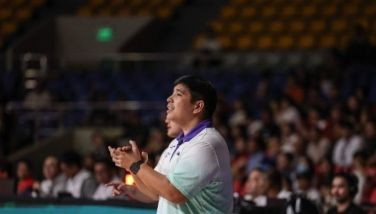A pathetic reaction to airport security audit

September 6, 2006 | 12:00am
Huling-huli na silang natutulog sa pansitan, humihirit pa!
That’s what’s unfortunate and pathetic in the reaction of NAIA authorities to published reports that an antiterrorism expert, on a mission to test security procedures at the airport, was able to smuggle and assemble a bomb onto a flight from Manila to Davao City on Aug. 14.
Alfonso Cusi, general manager of the Manila International Airport Authority, insisted the security audit was unauthorized and has violated international aviation laws. Cusi said the country’s Office for Transportation Security (OTS), which is under the Department of Transportation and Communications, is the only authorized agency to conduct an airport security audit. The OTS denied it has anything to do with the supposed security test.
But Justice Secretary Raul Gonzalez didn’t agree with Cusi. The Justice Secretary was quoted by published reports to have said that the expert did not violate any law in conducting the security test. "This person did not endanger anyone. I think that in order to find out how well prepared we are, we should not notify the airport security. Otherwise they will prepare. We have to test the situation when somebody is unaware of it." Oo nga naman!
The security expert said the government official who hired him wanted no one to know about the exercise "because what is the point of doing it if everybody is prepared." He said his biggest frustration was that he was not caught. The anti-terror expert said he was, in fact, hoping he would get caught, for it would mean that the human and technical aspects of the security procedures he was testing were working well.
When he breached the security networks at two premier domestic airports in the country, the civilian antiterrorism expert knew he was testing the limits and taking great risks because he could get caught and end up in jail for possessing explosive components he knew very well were illegal. The components included a small blasting cap, an adaptor inside of which he said he had hidden some C4 plastic, and a cell phone.
He had secreted the bomb materials in his jacket, computer bag, belt and shoes. But Davao City Mayor Rodrigo Duterte, said later that no real explosives were carried on board the airplane, just ordinary clay. "The point I was trying to prove," the security expert said, "was the laxity and the human factor of security here. Do airport personnel know what to look for and where to look?"
Instead of denouncing the security expert for not coordinating with them or violating the law (which the Justice Secretary said didn’t happen), NAIA officials should just humbly admit they failed an important test and do something about it. But what can you expect with people who can’t even manage that horrible Domestic Terminal properly? I am not surprised they were found wanting.
And they should stop trying to find out who is the top government official who hired the security expert to conduct his test. For all they know, it was Ate Glue herself who ordered it. What would they now do if the President said she hired the expert? They have already said so many silly things as they tried to weasel out of their predicament.
Come to think of it, perhaps Ate Glue can come up with a variation of the "secret shopper" program that department stores in the US have. This time, the "secret shopper" would be testing the front line bureaucracies of government – those dispensing passports, licenses, birth certificates, etc – to test which of these agencies are falling on their duties to serve the public quickly, honestly and professionally. No previous notice of the test must be given to agencies.
The other important lesson we should learn from that test, this time as passengers and airline crew members, is always be observant and vigilant while on board. The expert was supposed to have shown a video that showed him taking off his shoes and exposing the blasting cap attached to the sole. He said he shot that portion of the video while sitting in the mid-row section of the aircraft.
He said the person next to him did nothing while he was doing all that and taking the video as well. That’s a little difficult to believe. He also said he deliberately spent a long time inside the lavatory to see if any of the passengers or flight attendants would suspect anything. They suspected nothing. If he were a real terrorist, that flight would have been a goner.
If I were in the shoes of those NAIA officials, I would be deathly scared that a real terrorist might simulate everything that expert did and get away with it. If that happens, they can’t say they have not been warned. So, instead of wasting time and making themselves look silly denouncing the expert for their imagined violation of the law and not coordinating with them, they should just review their procedures and make sure that next time, hindi sila malusutan.
It now seems that the Biofuels bill which mandates the use of ethanol for all cars is, as I thought, not technically feasible. According to the Chamber of Automotive Manufacturers of the Philippines Inc. (CAMPI), 40 percent or about two million of the five million registered vehicles in the country cannot run on ethanol blended fuels.
CAMPI technical head Allen Rufo explained that many vehicles in the country still run with carburetors on their engines, as opposed to the newer fuel injection system engines. These vehicles with carburated engines are not fit for biofuels since the engines find it harder to adjust to the changes in the oxygen content of biofuels, which results in higher emissions.
Having been a veteran of the first market test of alcogas in Bacolod in the 1980s, I know how technical problems can kill a program as good intentioned as this one. Once cars start stalling on the road for whatever reason, the first suspect in the minds of people is the altered fuel. Ridiculous as it may seem, a motorist even tried to blame his flat tire on alcogas.
Our problem in this country is the longevity of cars. Thirty- year old cars or even older can still be seen in our streets. And the problem of older cars is that many of their parts, the plastics and the rubber parts, are not compatible with alcohol. While it is true that there have been vast improvements in materials technology since our alcogas days, our old cars still have those old incompatible parts.
With 40 percent of cars unable to use ethanol enhanced gasoline, they will have to take away the compulsory nature of using ethanol. But once there is a choice, people will hesitate to use the new product. That is why it is important to get CAMPI on board because if they just say nothing about the product being safe to use even on new cars, there will be very little shift.
At the initial part of the program, that is not such a bad thing. It would take time anyway to get the farmers to plant the sugarcane for the ethanol and for the distilleries to be set up. And with the price of sugar going up in the world market, because of an increased demand for fuel ethanol, sugar farmers will probably have second thoughts about selling to the local ethanol program. It would be easier to just export and earn the foreign exchange right away.
The message I want to convey here, based on our experience with alcogas is for proponents of the fuel ethanol program to make sure the car manufacturers are on board. It is counterproductive to be denouncing the car manufacturers as some proponents are doing now. Without their blessing, the program will not only be a dud, it would cause a lot of ill-will towards government. And Ate Glue can no longer afford an additional cross.
Norbert Goldie sent this one.
An elderly gentleman had serious hearing problems for a number of years. He went to the doctor and the doctor was able to have him fitted for a set of hearing aids that allowed the gentleman to hear 100 percent.
The elderly gentleman went back in a month to the doctor and the doctor said, "Your hearing is perfect. Your family must be really pleased that you can hear again."
The gentleman replied, "Oh, I haven’t told my family yet. I just sit around and listen to the conversations. I’ve changed my will three times!"
Boo Chanco’s e-mail address is [email protected]
That’s what’s unfortunate and pathetic in the reaction of NAIA authorities to published reports that an antiterrorism expert, on a mission to test security procedures at the airport, was able to smuggle and assemble a bomb onto a flight from Manila to Davao City on Aug. 14.
Alfonso Cusi, general manager of the Manila International Airport Authority, insisted the security audit was unauthorized and has violated international aviation laws. Cusi said the country’s Office for Transportation Security (OTS), which is under the Department of Transportation and Communications, is the only authorized agency to conduct an airport security audit. The OTS denied it has anything to do with the supposed security test.
But Justice Secretary Raul Gonzalez didn’t agree with Cusi. The Justice Secretary was quoted by published reports to have said that the expert did not violate any law in conducting the security test. "This person did not endanger anyone. I think that in order to find out how well prepared we are, we should not notify the airport security. Otherwise they will prepare. We have to test the situation when somebody is unaware of it." Oo nga naman!
The security expert said the government official who hired him wanted no one to know about the exercise "because what is the point of doing it if everybody is prepared." He said his biggest frustration was that he was not caught. The anti-terror expert said he was, in fact, hoping he would get caught, for it would mean that the human and technical aspects of the security procedures he was testing were working well.
When he breached the security networks at two premier domestic airports in the country, the civilian antiterrorism expert knew he was testing the limits and taking great risks because he could get caught and end up in jail for possessing explosive components he knew very well were illegal. The components included a small blasting cap, an adaptor inside of which he said he had hidden some C4 plastic, and a cell phone.
He had secreted the bomb materials in his jacket, computer bag, belt and shoes. But Davao City Mayor Rodrigo Duterte, said later that no real explosives were carried on board the airplane, just ordinary clay. "The point I was trying to prove," the security expert said, "was the laxity and the human factor of security here. Do airport personnel know what to look for and where to look?"
Instead of denouncing the security expert for not coordinating with them or violating the law (which the Justice Secretary said didn’t happen), NAIA officials should just humbly admit they failed an important test and do something about it. But what can you expect with people who can’t even manage that horrible Domestic Terminal properly? I am not surprised they were found wanting.
And they should stop trying to find out who is the top government official who hired the security expert to conduct his test. For all they know, it was Ate Glue herself who ordered it. What would they now do if the President said she hired the expert? They have already said so many silly things as they tried to weasel out of their predicament.
Come to think of it, perhaps Ate Glue can come up with a variation of the "secret shopper" program that department stores in the US have. This time, the "secret shopper" would be testing the front line bureaucracies of government – those dispensing passports, licenses, birth certificates, etc – to test which of these agencies are falling on their duties to serve the public quickly, honestly and professionally. No previous notice of the test must be given to agencies.
The other important lesson we should learn from that test, this time as passengers and airline crew members, is always be observant and vigilant while on board. The expert was supposed to have shown a video that showed him taking off his shoes and exposing the blasting cap attached to the sole. He said he shot that portion of the video while sitting in the mid-row section of the aircraft.
He said the person next to him did nothing while he was doing all that and taking the video as well. That’s a little difficult to believe. He also said he deliberately spent a long time inside the lavatory to see if any of the passengers or flight attendants would suspect anything. They suspected nothing. If he were a real terrorist, that flight would have been a goner.
If I were in the shoes of those NAIA officials, I would be deathly scared that a real terrorist might simulate everything that expert did and get away with it. If that happens, they can’t say they have not been warned. So, instead of wasting time and making themselves look silly denouncing the expert for their imagined violation of the law and not coordinating with them, they should just review their procedures and make sure that next time, hindi sila malusutan.
CAMPI technical head Allen Rufo explained that many vehicles in the country still run with carburetors on their engines, as opposed to the newer fuel injection system engines. These vehicles with carburated engines are not fit for biofuels since the engines find it harder to adjust to the changes in the oxygen content of biofuels, which results in higher emissions.
Having been a veteran of the first market test of alcogas in Bacolod in the 1980s, I know how technical problems can kill a program as good intentioned as this one. Once cars start stalling on the road for whatever reason, the first suspect in the minds of people is the altered fuel. Ridiculous as it may seem, a motorist even tried to blame his flat tire on alcogas.
Our problem in this country is the longevity of cars. Thirty- year old cars or even older can still be seen in our streets. And the problem of older cars is that many of their parts, the plastics and the rubber parts, are not compatible with alcohol. While it is true that there have been vast improvements in materials technology since our alcogas days, our old cars still have those old incompatible parts.
With 40 percent of cars unable to use ethanol enhanced gasoline, they will have to take away the compulsory nature of using ethanol. But once there is a choice, people will hesitate to use the new product. That is why it is important to get CAMPI on board because if they just say nothing about the product being safe to use even on new cars, there will be very little shift.
At the initial part of the program, that is not such a bad thing. It would take time anyway to get the farmers to plant the sugarcane for the ethanol and for the distilleries to be set up. And with the price of sugar going up in the world market, because of an increased demand for fuel ethanol, sugar farmers will probably have second thoughts about selling to the local ethanol program. It would be easier to just export and earn the foreign exchange right away.
The message I want to convey here, based on our experience with alcogas is for proponents of the fuel ethanol program to make sure the car manufacturers are on board. It is counterproductive to be denouncing the car manufacturers as some proponents are doing now. Without their blessing, the program will not only be a dud, it would cause a lot of ill-will towards government. And Ate Glue can no longer afford an additional cross.
An elderly gentleman had serious hearing problems for a number of years. He went to the doctor and the doctor was able to have him fitted for a set of hearing aids that allowed the gentleman to hear 100 percent.
The elderly gentleman went back in a month to the doctor and the doctor said, "Your hearing is perfect. Your family must be really pleased that you can hear again."
The gentleman replied, "Oh, I haven’t told my family yet. I just sit around and listen to the conversations. I’ve changed my will three times!"
Boo Chanco’s e-mail address is [email protected]
BrandSpace Articles
<
>
- Latest
- Trending
Trending
Latest
Trending
Latest
Recommended






























